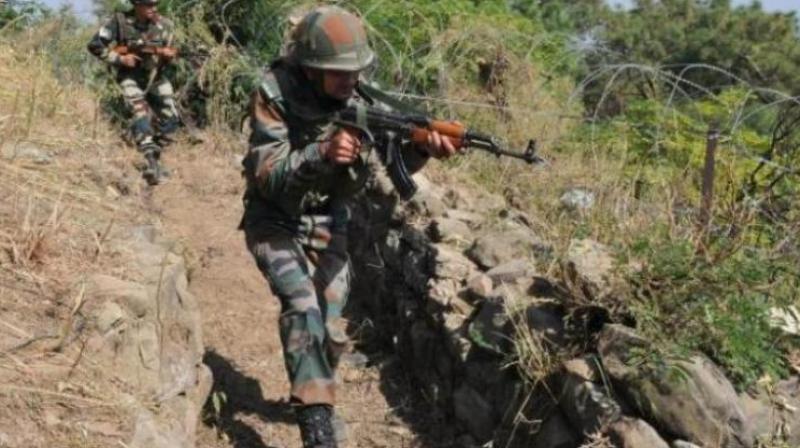The divide is growing in a fragmented Jammu & Kashmir

Three trends in Jammu and Kashmir stand out in the year 2018 — the conflation of civilian protests with militancy in the Valley; a complete breakdown in the political consensus between the Valley and the rest of the state; and the further fragmenting of opinion within the Kashmir Valley itself. The year came to a close with the tragic death of six civilians during an encounter in the Valley’s Pulwama district. This horrific event, which also saw the killing of three hardcore terrorists and an Army soldier, marked the culmination of a process that has been gathering steam for more than a year.
Increasingly, civilian supporters of the Kashmir militancy, especially the youth, are actively conniving with terrorists to disrupt counter-insurgency operations and highlight their narrative of resistance.
Civilian killings by the security forces feeds a dynamic set in motion by the terrorist masterminds in the Valley and across the border in Pakistan. It reinforces the narrative that New Delhi is brutally suppressing the “freedom-loving” people of the state of Jammu and Kashmir.
The images of civilians with bullet wounds, mass funerals and frenzied mobs chanting anti-India slogans fuel the anti-Indian narrative which is broadcast by Pakistan and its proxies all over the world, including forums such as the United Nations and the Organisation of Islamic Conference. The notion of Indian repression in Kashmir is thereby further concretised in the global mind. Nuances are lost and so is the reality of deadly provocation by huge mobs of extremely violent youth assaulting the Indian security forces at encounter sites, compelling them to retaliate and thereby keeping in motion the cycle of violence, protest and alienation.
This is a trend that is gathering momentum and for which the Indian State really has no ans-wer or effective respo-nse. The other development, which is mostly lost to the outside world, is the vast political div-ergence between the Valley and the rest of the state. That Jammu and Kashmir is not the Valley alone was evident when the coalition government formed between two unlikely political parties, the Bharatiya Janata Party and the People’s Democratic Party, collapsed this June, ushering in another round of Governor’s Rule.
The BJP in the state represents mainly the Jammu region, which generally does not support the insurgency. There is no militancy here and no resonance for the notions of secession from India. If anything, there is a powerful pro-India lobby that dominates the politics of this region. This was evident during the urban local bodies and rural polls held in the state during October-November this year. The response to these elections was overwhelming in the Jammu region and in Ladakh, with the voter turnout at over 70 per cent.
In contrast, there was virtually zero polling in the three militancy-affected south Kashmir districts of Pulwama, Shopian and Kulgam. The overall voting percentage in the Valley was about 30 per cent.
Politics in the state today is completely divided and unlikely to meld in the near future. The BJP in the state also largely represents the non-Kashmiri populace, that has tasted state power for the first time in decades. The rise of non-Kashmiri political power is bound to have major long-term repercussions on the state.
The PDP represents mostly Valley Kashmiri interests and had received overwhelming voter support in the 2016 state elections because the average Valley Kashmiri voter wanted to keep the BJP out of power.
The unanticipated collation between the PDP and the BJP came as a shock to the Valley’s Kashmiris. For the first time in history, the political supremacy of the Valley Kashmiri was challenged and the PDP might never be forgiven for allowing this to happen.
The third trend, which is gradually becoming evident, are major differences in opinion within the Kashmir Valley itself. The fact that 30 per cent of the Valley’s electorate decided to participate in the elections to grassroots democratic institutions this year despite the vote boycott called by the separatists and terrorist threats points to the differences in political perceptions.
At another level, the state is witnessing slow but inexorable changes in the structure of mainstream politics, which has traditionally been dominated by two dynasties, one represented by the National Conference leader Farooq Abdullah and his son Omar Abdullah, and the other Mehbooba Mufti, who inherited the leadership of the PDP from her late father, Mufti Mohammad Sayeed. This stranglehold could also end with new aspirants such as Sajad Lone entering the fray and new political combinations emerging.
The official discourse on the state of Jammu and Kashmir rests on the view that the state is one vast united, inviolate entity. History, however, suggests that the state was an artificial construct cobbled together by the military might of the Dogra rulers emboldened by the blessings of the powerful British Raj.
Once the Raj ended, the somewhat inevitable process of dissolution began. One great chunk of the state’s territories was usurped by China and another seized by Pakistan, leaving the prized Valley, the Jammu region and the desolate wastes of Ladakh under India’s rule.
Today, as the year 2018 demonstrated, even the areas under Indian rule are riven with fundamental schisms. Ladakh has been long agitating for autonomy and Union territory status; the Jammu region is on the whole has hitched its destiny to a resurgent India; and it is only the Kashmir Valley which is on a wholly different tangent, seeking autonomy, secession or reconciliation.
Events of the year 2018 unequivocally suggest it is only the Government of India and its implacable foe, the Kashmiri separatist bloc, who continue to hold on to the myth of an undivided state. The fact is, history has never seen a more fragmented and divided state of Jammu and Kashmir. It is time that we accept this reality.
The writer is an independent commentator on political and security issues

